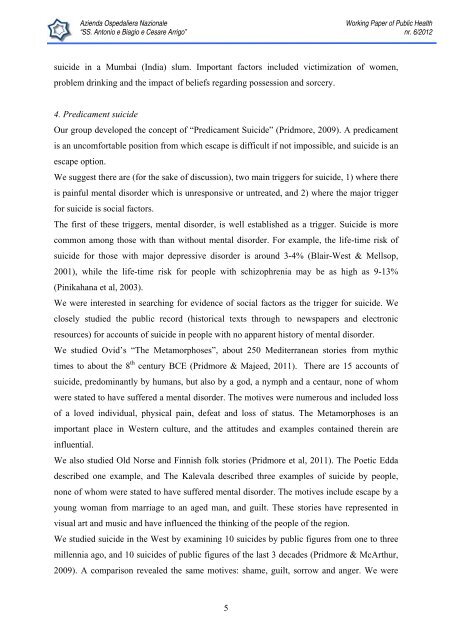Working Paper of Public Health Volume 2012 - Azienda Ospedaliera ...
Working Paper of Public Health Volume 2012 - Azienda Ospedaliera ...
Working Paper of Public Health Volume 2012 - Azienda Ospedaliera ...
You also want an ePaper? Increase the reach of your titles
YUMPU automatically turns print PDFs into web optimized ePapers that Google loves.
<strong>Azienda</strong> <strong>Ospedaliera</strong> Nazionale“SS. Antonio e Biagio e Cesare Arrigo”<strong>Working</strong> <strong>Paper</strong> <strong>of</strong> <strong>Public</strong> <strong>Health</strong>nr. 6/<strong>2012</strong>suicide in a Mumbai (India) slum. Important factors included victimization <strong>of</strong> women,problem drinking and the impact <strong>of</strong> beliefs regarding possession and sorcery.4. Predicament suicideOur group developed the concept <strong>of</strong> “Predicament Suicide” (Pridmore, 2009). A predicamentis an uncomfortable position from which escape is difficult if not impossible, and suicide is anescape option.We suggest there are (for the sake <strong>of</strong> discussion), two main triggers for suicide, 1) where thereis painful mental disorder which is unresponsive or untreated, and 2) where the major triggerfor suicide is social factors.The first <strong>of</strong> these triggers, mental disorder, is well established as a trigger. Suicide is morecommon among those with than without mental disorder. For example, the life-time risk <strong>of</strong>suicide for those with major depressive disorder is around 3-4% (Blair-West & Mellsop,2001), while the life-time risk for people with schizophrenia may be as high as 9-13%(Pinikahana et al, 2003).We were interested in searching for evidence <strong>of</strong> social factors as the trigger for suicide. Weclosely studied the public record (historical texts through to newspapers and electronicresources) for accounts <strong>of</strong> suicide in people with no apparent history <strong>of</strong> mental disorder.We studied Ovid’s “The Metamorphoses”, about 250 Mediterranean stories from mythictimes to about the 8 th century BCE (Pridmore & Majeed, 2011). There are 15 accounts <strong>of</strong>suicide, predominantly by humans, but also by a god, a nymph and a centaur, none <strong>of</strong> whomwere stated to have suffered a mental disorder. The motives were numerous and included loss<strong>of</strong> a loved individual, physical pain, defeat and loss <strong>of</strong> status. The Metamorphoses is animportant place in Western culture, and the attitudes and examples contained therein areinfluential.We also studied Old Norse and Finnish folk stories (Pridmore et al, 2011). The Poetic Eddadescribed one example, and The Kalevala described three examples <strong>of</strong> suicide by people,none <strong>of</strong> whom were stated to have suffered mental disorder. The motives include escape by ayoung woman from marriage to an aged man, and guilt. These stories have represented invisual art and music and have influenced the thinking <strong>of</strong> the people <strong>of</strong> the region.We studied suicide in the West by examining 10 suicides by public figures from one to threemillennia ago, and 10 suicides <strong>of</strong> public figures <strong>of</strong> the last 3 decades (Pridmore & McArthur,2009). A comparison revealed the same motives: shame, guilt, sorrow and anger. We were5













![[torino - 1] lastampa/urc/01 ... 26/10/09 - Azienda ...](https://img.yumpu.com/44058002/1/190x32/torino-1-lastampa-urc-01-26-10-09-azienda-.jpg?quality=85)


